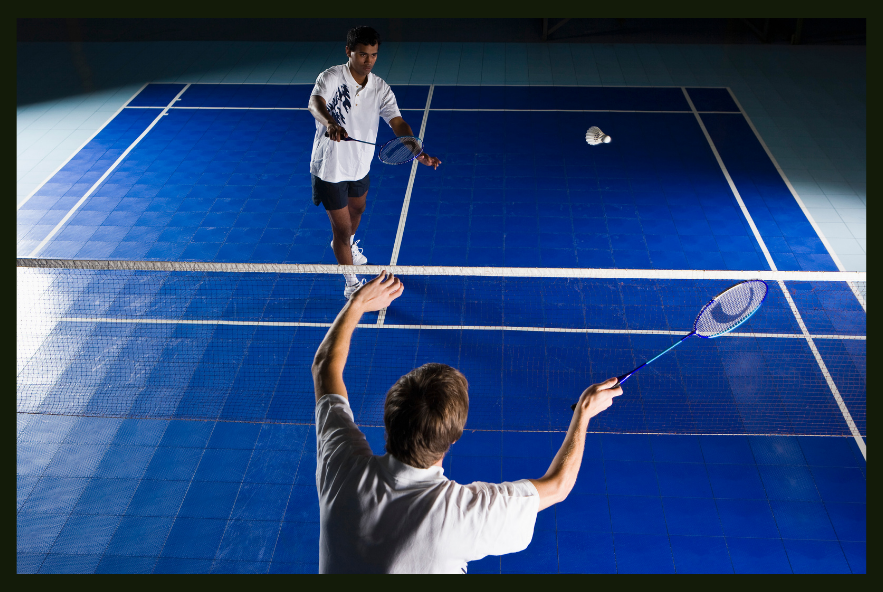Disclosure : Some of the links in this post may be affiliate links.
You may be wondering “Why is badminton played indoors ?”. It’s true that you can play badminton outdoors and on any court, but it’s also true that badminton is a form of competitive sport that can be played indoors.
Badminton is an inside sport, as the shuttlescock, the sport’s basic part, is designed to fit in controlled indoor spaces. Players must move rapidly and successfully forecast where the shuttlecock will go owing to the game’s indoor areas. Rain or other outside factors might impact the flight pattern of the shuttlecock, which could impact the competitiveness of the game.
Badminton is popular as an indoor game because it is relatively small and doesn’t take up much space. It is also a relatively fast game, so it can be played in shorter amounts of time.

Contents
Outdoor Factors That Affect Competitive Gameplay
Playing badminton for pleasure is possible both indoors and outdoors. Outdoor badminton still offers the challenge of wind interference, which can make the game more difficult.
The Badminton World Federation (BWF) is researching efficient alternatives to wrestling with Badminton, which is typically played outdoors and has various difficulties. Here, in this informative article, we will investigate the reasons why outdoor badminton remains challenging.
Wind
The wind has a significant effect on the shuttlecock in badminton. When playing in a strong wind, players need to account for the added force that the wind will have on the shuttlecock. This means that they will need to hit the shuttlecock harder and with more accuracy than they would in a calm environment. In a strong wind, the shuttlecock can be blown off course or even out of bounds. For this reason, many professional tournaments are played in indoor arenas where the wind cannot affect the game. Basketball, tennis, soccer, and badminton all use balls in one way or another to keep things moving.
The shuttlecock’s design, in which the feathers are attached to a durable cork base, prolongs its flight. As the direction changes depending on the wind gusts, this attribute can be utilized to the competition.
Compared to tennis balls and golf balls, which are both around 50 to 60 grams, the shuttlecock weighs only about 5 grams. Due to this, the shuttlecock is much less able to withstand the force of the wind, which can make it more difficult to control its trajectory. This allows it to be blown by the wind more easily than a heavier ball.
Because of the light quality of the shuttlecock, its flight speed is considerably increased if you hit it with a light stroke of the racket. As it travels through the air, the wind influences how fast it moves, which means it doesn’t always fly straight. The wind adds to this movement, and it whisks the shuttlecock back and forth.
Lightning
The next consideration when selecting a ball for outdoor badminton is the matter of light. Constant levels of light make visibility more challenging when seeing the shuttlecock.
Playing outside means you will be looking up the shuttlecock above head level, which is usually at the same time. Since the sun is also in the same direction, it might be hard to play outside at times.The sunlight’s glare will undoubtedly distract you from seeing the ball. As a result of the sun’s glare, you will be completely deprived of the game.
Playing badminton at night comes with its own set of issues. One of the most important is visibility. Without good lighting, it can be difficult to see the shuttlecock, which can lead to dangerous situations. Additionally, playing in an outdoor setting when it’s dark can be risky because of potential tripping hazards. Another thing to consider when playing at night is the temperature; it might be colder than during the day. It’s common for them to be configured in spots that obstruct visibility, casting shadows or blinding the players, even in instances in which they do have adequate lighting.
Lighting conditions on the court may often lead to players being injured because they often have to run around.
Bad Flooring
Since the players have to move around the court, flooring plays an important role in the sport’s safety and in the overall competition.

The BWF recommends wooden flooring with a vinyl impact absorbent covering and a mat for badminton courts in order to maximize mobility. This material is well suited for badminton players who want agile footing without risking a broken leg or ankle. Outdoor courts are designed to reduce the risk of injury because they are frequently poorly maintained. If you are on grass or sand, the ground can actually make it pretty challenging to move around quietly and quickly. If you force yourself to do so and take a badminton match as a competitive sport seriously, you will be unnecessarily putting yourself at risk for repeat injuries if you stumble to the ground and fall.
What about a concrete court?
Concrete courts do not provide a flat surface for fast-moving scrimmages because of drag and friction. Hence, you are still at risk of sustaining injuries if you play competitively on these types of terrain.
Possibility of Rain, Snow, or Hail
Weather conditions can affect your badminton experience. Whether it’s humid, cold, or if it’s too rainy or hot, these conditions can decrease or enhance your badminton game, accordingly.
Playing outside during the heat’s peak may result in you sweating and losing a lot of your body fluids, making you vulnerable to fainting and resulting in lightheadedness. This can be prevented by going to outdoors just instead of during the heat’s peak.
While the weather is undoubtedly one of the most influential factors on your badminton game. In areas where hail is known to fall every year, for instance, you can expect to see damaged badminton equipment. If you are playing a game of badminton outside and it starts to rain, your game will be negatively impacted. This is because the rain will make the court wet and slippery, making it difficult to play on.
The weather of snowing can affect how well you play badminton.. If it is snowing, then the ground will be wet and icy, which will make it difficult to run around and hit the birdie.
The weather’s inherent unpredictability makes it difficult to maintain consistent badminton play, limiting competitive possibilities in regions where weather conditions are poor.
Why is badminton best played indoors ?
The common question that people also ask “Can badminton be played indoors ?”, the answer is yes, indoor is perfectly for playing badminton.
As previously noted, badminton we’re talking about right now is known as the competitive and professional sport. However, badminton is a great sport to play outdoors with friends. All you need is your badminton equipment, a net, and a desire to simply have fun. Badminton is easy to learn and can be enjoyed by people of all ages. Playing badminton outdoors is a great way to get some fresh air and exercise.
Shuttlecock badminton is only played indoors due to its benefits for enabling players to maximize mobility and facilitate shuttlecock movement, which is an important aspect of the sport. Playing badminton indoors offers a wide range of benefits for competitive play.

Firstly, you do not need to worry about sustaining bumps or uneven terrain, because indoor badminton courts are built in accordance with BWF regulations and use the standardized floor materials mandated.
Secondly, the shuttlecocks do not have sharp ends so they’re not affected by strong gusts of wind. This allows players to determine where the shuttlecocks will go, thus helping them provide accurate disruptions.
You’re also not subject to destructive weather, protecting your equipment from harm and ensuring that you are safe from health-related injuries that are prevalent in the weather conditions.
Players and spectators can enjoy a friendly rivalry on badminton courts. Crowds gather, cheering, chuckling, and making the usual banter of badminton, making the game more exciting.
Final Thoughts
Badminton can quickly become fiercely competitive. This makes it important to make sure that the place you’re playing is suitable for the sport.
So to answer question “can badminton be played outdoors ?” It is yes, badminton is suitable for outdoor fun. If you go on a badminton tournament or will be a professional player, an indoor court is the ideal location for badminton. After reading this post, you are confident to answer yourself “why badminton played indoors”. See you in next post !
FAQ
Why badminton is played indoor not outdoor ?
Badminton is played indoors because the smaller playing area makes it more difficult to hit the birdie over the net. Indoors, there is also less wind interference, making the game fairer.
can you play badminton indoors in scotland ?
Yes, you can play badminton indoors in Scotland. However, the weather can be unpredictable so it’s always a good idea to check the forecast before heading to the badminton court.
Can I play badminton indoors in tier 2 ?
Yes, you can play badminton indoors in tier 2. The game is typically played in a gym or other large indoor space.
Can you play badminton indoors in tier 3
Yes, you can play badminton indoors in tier 3. However, the quality of the playing surface may not be as good as those in higher tiers.
Amazon and the Amazon logo are trademarks of Amazon.com, Inc, or its affiliates.
Hi there, my name is John Duong, and I'm a 10-year experienced badminton player. Badminton is my passion, and I've been playing the sport competitively since I was a teenager. Over the years, I've honed my skills, developed my technique, and gained valuable insights into the game.
